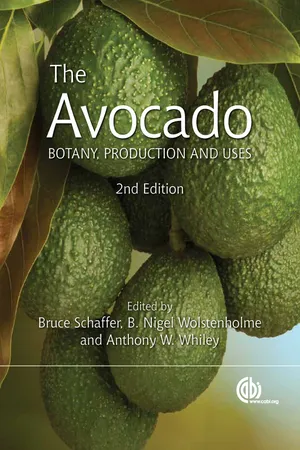Biological Sciences
Armillaria
Armillaria is a genus of fungi that includes several species known as honey fungi. These fungi are parasitic and can cause root rot in trees and woody plants. They are also known for their ability to form large, long-lived colonies, making them important in forest ecology and as a model for studying fungal genetics and evolution.
Written by Perlego with AI-assistance
Related key terms
1 Key excerpts on "Armillaria"
- eBook - ePub
Avocado
Botany, Production and Uses
- Bruce Schaffer, B Nigel Wolstenholme, Anthony W Whiley(Authors)
- 2013(Publication Date)
- CAB International(Publisher)
Armillaria spp. can be recovered from diseased tissue or rhizomorphs on malt agar amended with o-phenylphenol (Shaw and Kile, 1991); they produce hyphae with clamp connections, red-brown crustose areas, and no spores. Light inhibits colony growth.Before the 1970s, the name ‘Armillaria mellea ’ was used for almost all members of the genus (Burdsall and Volk, 1993). In the ensuing decades, morphological (primarily stipe and pileus appearance), biological (mating behaviour) and genetic data were used to recognize ten species in North America, two of which affect avocado.Armillaria mellea (Vahl ex Fr.) Kummer (sensu stricto hereafter) has a wide host range of mainly tree species. It is comprised of four geographically and genetically distinct populations in Asia, Europe, and eastern and western North America (Coetzee et al ., 2000); presumably, the latter population is responsible for the disease of avocado in California. A . mellea produces mushrooms in clusters of eight to 30 or more. Stipes have an annulus and are narrow at the base. The pileus is honey coloured with a smooth surface and no squamules. Basidiospores are 7.2–8.9 × 5.6–6.7 μm and, atypically for the genus, there are no clamp connections at the base of basidia (Coetzee et al ., 2000; Burdsall and Volk, 1993).In Florida, A . tabescens (Scop.) Emel (syns. A . socialis and Clitocybe tabescens ) is the causal agent (Menge and Ploetz, 2003). It is common in the southeastern USA, where it affects more than 200 plant species. It probably differs from a species in Europe with the same name (Shaw and Kile, 1991). It forms clusters of eight to 50 or more mushrooms. Stipes of A . tabescens do not have an annulus, and basidiospores are 8–10 × 5-7 μm. Unlike A . mellea , A . tabescens does not produce rhizomorphs in soil.The species of Armillaria that are responsible for this disease in other avocado-production areas are not clear. Work is warranted to identify the responsible species in other areas and to determine if species other than A . mellea and A . tabescens
Learn about this page
Index pages curate the most relevant extracts from our library of academic textbooks. They’ve been created using an in-house natural language model (NLM), each adding context and meaning to key research topics.
